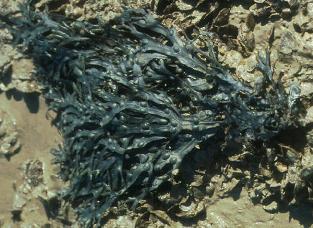
Nutrition - You are what you eat!
The Synthesis of Photons?
(Photosynthesis)
Fucus vesiculosus is able to undergo a process called
photosynthesis. Through this process, F. vesiculosus is
able to produce sugars for itself. The brown algae does this
with structures called chloroplasts, which contain certain
pigments that are able to capture the sun's energy and convert
this light energy into a useable form of chemical energy,
glucose, which the cells can use as its main source of energy.
The only chemicals bladderwrack needs to undergo photosynthesis
are carbon dioxide (CO2) and water (H2O).
The chemical reaction is shown below:
6 CO2 + 6 H2O àC6H12O6 + 6 O2
 All species of brown algae contain pigments called
Chlorophyll a , which is what gives plants and
green algae their characteristic green color. But the pigment
that sets brown algae apart from plants is Chlorophyll c. Brown
algae also have pigment that can be classified as a caretenoid called fucoxanthin. This pigment ends up masking the
chlorophylls to give the brown algae their brown color.
Fucoxanthin helps F. vesiculosus capture a broader
spectrum of light, allowing the organism to use more energy from
the sun, and making the whole process of photosynthesis more
efficient. The picture to the right shows F. vesiculosus
in a slightly greener state. The reason for the darker green and
not the green you see on most land plants is because of the
fucoxanthin. You can learn about another algae by visiting the
site on
Spirogyra Longata.
Not only do algae and plants, both of which have a nucleus,
undergo photosynthesis, some organisms without a nucleus do as
well. You can learn more about this very intriguing happenstance
by going to the site on the genus
Anabaena.
All species of brown algae contain pigments called
Chlorophyll a , which is what gives plants and
green algae their characteristic green color. But the pigment
that sets brown algae apart from plants is Chlorophyll c. Brown
algae also have pigment that can be classified as a caretenoid called fucoxanthin. This pigment ends up masking the
chlorophylls to give the brown algae their brown color.
Fucoxanthin helps F. vesiculosus capture a broader
spectrum of light, allowing the organism to use more energy from
the sun, and making the whole process of photosynthesis more
efficient. The picture to the right shows F. vesiculosus
in a slightly greener state. The reason for the darker green and
not the green you see on most land plants is because of the
fucoxanthin. You can learn about another algae by visiting the
site on
Spirogyra Longata.
Not only do algae and plants, both of which have a nucleus,
undergo photosynthesis, some organisms without a nucleus do as
well. You can learn more about this very intriguing happenstance
by going to the site on the genus
Anabaena.